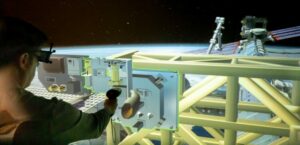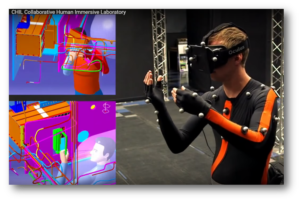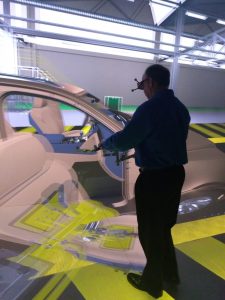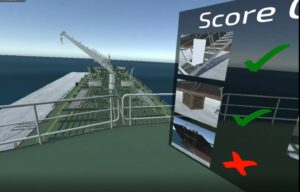Recently, a question came asking, “What is needed in a facility to effectively use/apply AR/VR technology in an industrial environment? If, for example, a maintenance person wants to train for a particular task using AR/VR tech, what physically is needed? ie: Space (square footage), fixtures, furniture, equipment, etc. is needed to support that?”

This is a very important consideration with any solution because the full cost of deploying an Augmented Reality (AR) or Virtual Reality (VR) system may need to include facility modifications along with the technology cost. This is true not just for industrial applications; all use cases should consider facility needs. As a response, we are providing some context and four key factors.
The short answer is ‘it depends’ but we know that will not be very helpful. Two critical pieces for effectively applying AR/VR technology in an industrial environment are, understanding what you seek to accomplish and why AR/VR is being used. When presented with a challenge like this, we start to think about things like:
- What are the different physical and sensory aspects of the task and environment?
- What might be the most important considerations for the trainee experience to provide the best return on effort?
- If doing safety or operational maintenance training, does AR/VR provide a way to communicate guidance information in a safe way?
- Does the use of AR/VR provide a way to present more information than would be otherwise available?
- What types of information would be needed for the AR/VR experience?
You can see there are many questions that will affect a recommendation. As an overall summary answer, here are four factors that will affect the facility requirements for VR training.
What exactly is being trained?
You mention you are doing a specific task in maintenance. Does the trainee’s body motions need to drive the interactions in the virtual/augmented environment? To what extent? Waist-up? Walking among certain distances? As an example, we have been asked to develop a VR training application for the repair or replacement of specific parts in a smaller machine. They have specific tools to use, all within reach. They don’t move much, are focused on a limited visual area, and don’t need to be concerned about the general surroundings. In this instance, a head-mounted VR display (HMD) with hand-held interaction wands could be ideal. The space needed is limited to a table to hold the HMD, the interaction devices, the computer to drive it (possibly a laptop), and as a convenient place for the trainee to sit down for additional presentations or written material. You may want to consider a wall-mounted or free-standing monitor so the trainer/observer can see what the trainee is seeing. Allowing for the trainee, trainer and equipment, typically, a minimum 10’ x 10’ room will keep things comfortable. Note that all current AR systems are head-worn or hand-held devices so the considerations are similar to an HMD.


At the other end of the spectrum, for example, you are training someone for hazardous environments or larger machines where the user needs to feel completely immersed in the space, a large video wall or walk-in CAVE may be appropriate. Filling peripheral vision heightens senses and gives an impressive sense of scale. A room-scale display does require more square footage. A typical, front-projected CAVE requires 10’x10’ space. If the projectors have to be behind the screens because of the training application, more space will be needed for the projectors and/or mirrors. Additional space will be needed for the computer(s) to drive the CAVE, pre and post-training briefings, as well as table(s) to hold materials. A larger system with projectors and a larger computing system may require changes in the HVAC and power in the space.
Where does the training need to take place?
If the training needs to happen within the actual factory/industrial setting, your display options become limited. AR is about the only way for a trainee to see actual machinery and training information at the same time. The choices then become AR glasses, a tablet, or other mobile device. Note that some VR HMDs have forward-facing camera systems that enable users to experience virtual or augmented reality through the same device. When the cameras are off, the user is in VR. When the cameras are on, the same display can overlay augmented images on the real environment conveyed through the cameras. Your only space consideration may be, where do pre and post-training activities occur and does that require dedicated space?
How many trainees are participating in the simulation?
As mentioned above, HMDs need limited space. You may be able to accommodate multiple trainees at one time by deploying several HMDs in the room. This can speed training and time to effectiveness for groups rather than individuals. Trainees could be working individually at desks. If the training involves a collaborative team, HMDs can be connected into a shared virtual environment. Shared tasks may dictate the need for a larger space depending upon how much trainees need to move around. Depending on the technology used, motion-tracking cameras mounted to walls or the ceiling to capture the movements of all trainees. Also, allow for the additional technology needed for more people. Group training can also occur in a CAVE or using a large video wall. The technology applied will depend on the nature of the training.

Where is your content coming from?
If you have decided to develop content internally, you will need a desk, computer and other tools for a content developer. They may need their own HMD/tablet to test the training simulations before deploying to trainees. That work can be done just about anywhere, even remotely. If you have a CAVE or wall solution, you still need the desk, etc. but the developer is best to be near the display so they have access to it for testing.
As mentioned, these are only four factors that will influence the design of a VR/AR training solution. There may be other considerations that are specific to your training requirements. A thorough discovery meeting, discussing the training, the environment, and the overall goals, will help a solution architect understand the complete training workflow. This is a must before any solution is recommended.


